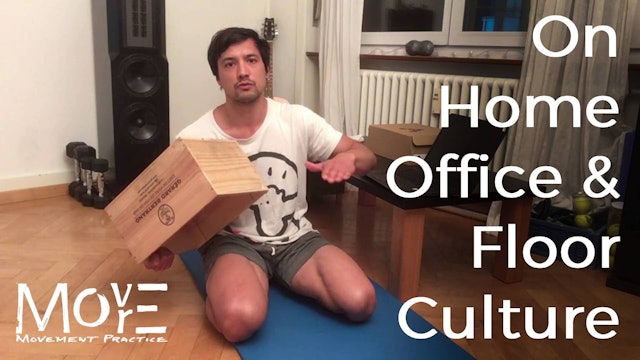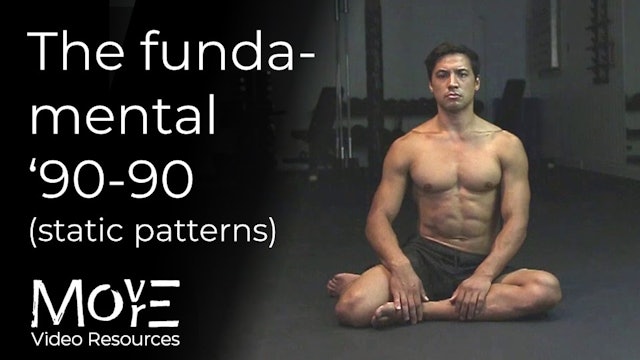Fundamental squat & hip-mobility development
The phrase “fundamental human-ranges” is not one thrown around so lightly as, despite the potential to invest in a variety of forms for mobility-development (from ‘global-extension’ & ‘front-folding’ to ‘leg-abduction’ & ‘compression’), few of these are so integral a range to natural movement potential of the human structure as is the ‘resting-squat’; this position effectively represents the maximum potential of a body to vertically-COMPRESS, the other end of the spectrum to EXTENDING/DE-COMPRESSING, as is expressed in HANGING-contexts (another fundamentally-human movement).
Before even considering benefits to health & function, then, a comfortable resting-squat simply affords a greater capacity to work in contact with the floor as, until entering in contact with the body, a deep squat is the CLOSEST in which we can bring ourselves to it whilst remaining bipedal. Being a position of maximal COMPRESSION, it is innately dependent on ranges of FLEXION, namely of the ankles in ‘dorsiflexion’, the knees in “deep-flexion”, and the hips in flexion & external-rotation (i.e. so the pelvis/torso can “sit” between the outward-flared knees. This is poignant for structure & mechanics in capacity-development contexts, such as the loaded ‘Front/back-squat’, as well in the unloaded ‘resting-squat’).
LEARN MORE (subscriber-only):
https://drive.google.com/file/d/1msuuKtbEgFatyh7jVHdCOMmUPzIx9NyL/view?usp=drive_link
-
Legs tendon-conditioning 2 (jumping)
THE WHAT:
Lower-body focused contexts for the development of tendon 'elasticity' and progressive joint-stability with focus on the ankles, knees, and hips. these are structured around three 'large-frame' mobility-forms: the squat, the 'horse-stance', and the 'long-lunge', each of which contribute... -
Legs tendon-conditioning 1 (grounded-bouncing)
THE WHAT:
Lower-body focused contexts for the development of tendon 'elasticity' and progressive joint-stability with focus on the ankles, knees, and hips. these are structured around three 'large-frame' mobility-forms: the squat, the 'horse-stance', and the 'long-lunge', each of which contribute... -
'Floor Culture' & the Home Office
‘FLOOR CULTURE’ is a dual perspective that firstly throws an eye toward the daily habits & practices of cultures which live in closer contact with the floor. Secondly, it represents my proposal of “culturing” such habits in your daily life as the most necessary practice to SUSTAINABLY regain the ...
-
Ankle-dorsiflexion development
THE WHAT:
Whist consistent practice of these two simple forms contributes toward developing range & elasticity in ankle-dorsiflexion, their form & position (i.e. 'hinged' in the hip), also affects the hamstrings of the 'working' leg. For this reason, they are equally valuable in developing FRONT-... -
Kneeling hip-flexor release
THE WHAT:
A supported contract/relax context for "releasing" available range in the hip-flexor-complex (i.e. maximally "opening" the hip). It's primary use-value is as a preparatory tool to establish what the nervous system will "allow" at that time, from which point more potent tools (namely tho... -
Quadriceps & hip-flexor stretches
THE WHAT:
Fundamental static stretches affecting the "hip-flexors" & quadriceps complex. Whist incomplete in themselves for developing sustainable and USABLE ranges in the long-term, their convenience allows them to be more easily cultivated into an habitual daily practice, one of the most powerf... -
Knee-elevated Kneeling hip-flexor release (KE-KHFR)
THE WHAT:
A simple variation on a classic hip-flexor 'release' drill performed by elevating the back knee and pulling through the ground with the FLAT FOOT, rather than the knee. This facilitates greater loading of the hip-flexor of the back leg, and also places more stress across the quadriceps ... -
The 'Active' Squat
THE WHAT:
The 'Active' squat is a form which is structurally sound to receive load and produce force from (e.g. as in the context of performing a 'Back squat'). Compared to the ‘Passive-squat’, in terms of range it requires LESS knee, hip, and ankle-flexion, although their development is still af... -
Squat mobility routine 1.0
THE WHAT:
An intensive hip-mobility routine designed to explore various patterns in and develop the ranges of the resting squat position. Along with the likes of 'front-folding' and overhead reaching, it can be truly considered a "fundamentally human" range, in that it has huge carry-over to both... -
The fundamental 'Dragon-Squat'
THE WHAT & HOW:
A static form whose investment begins by developing mobility capacities and conditioning in the lower-body, but ultimately serves as a fundamental 'zero point' through which to transition in bipedal locomotive practice.LEARN MORE (subscriber-only):
https://drive.google.com/file... -
The 'Fisherman squat'
THE WHAT:
The 'fisherman squat' is a fundamental 'zero-point' providing high transitional movement potential through & between the worlds of standing, kneeling, sitting, and floor-contact. It is also a common departure & arrival position for dynamic floor-contact movements, such as rolling, and i... -
The Fundamental ’90-90’ (static patterns)
THE WHAT:
The ’90-90’ is essentially a common floor-seated position in which the bodyweight is shifted more unilaterally into one side of the hips, the shins forming a more-or-less square form at a 90-degrees angle.When available, it serves as a fundamental ‘zero-point’ through which high trans...
-
Active/passive QL +' 90-90' stretch
THE WHAT:
An explorative and potentially therapeutic stretching context combining breathing, loading, and tension-modulation. As the inhale couples with an 'active' stretch to tighten the structure, the exhale relaxes 'passively' into any deeper range of frontal spinal-flexion "allowed" by the ne... -
Cross-legged & active 'Pigeon-stretch'
THE WHAT & HOW:
These ‘Cross-legged’ and ‘Active pigeon-stretch' variations offer specific mobility-development contexts in which to explore loading of the hip in an externally-rotated position. A forward “hinge” and “folding” the upper-body as far as possible over the legs then serves to LOAD th... -
90-90 end-range iso routine
THE WHAT:
A unilateral routine focused on developing experience in the end-ranges of internal hip-rotation (IR). As well as an isometric contraction to enter & maintain active end-range IR, as the force of gravity is also working against the leg there is also a consistent intention for active COM... -
Squat 'Proofing'
THE WHAT:
'Proofing' for the squat, affecting the toes, ankles, knees, hips, lumbar spine & posterior chain. Be sure to check out the 'Perspective of Proofing' resource for a foundational understanding of this concept to support ongoing practice: https://youtu.be/J5sM4EXL290Rather than the repe...
-
'Low-gait' Squat (LGS) development
THE WHAT:
'Low-gait': the bipedal world between standing and floor-entrance. These drills focus on the "deepest" range from which floor-entrance is most accessible - if the experience and mobility capacities are available. Whilst consistent practice of these drills will help DEVELOP those ranges,... -
'Open-hip knee-kiss' & Elevated 'Toe-rocking'
THE WHAT:
Here the concept of an 'open-hip' (i.e. hip-extension) initiated from the squat position is explored in both unilateral ('Knee-kiss') and bilateral ('Toe-rock') contexts. From a capacity-development perspective, the toes are exposed to loading in their maximally extended position, and w... -
Low-gait 'meia lua'
THE WHAT:
At the lowest-of-the-'low-gait' contexts sits the maximally-compressed squat form, from which any lower in space must be a transition into the floor. 'Low-gait balance contexts' (namely unilateral), then, carry both the valuable experience of unilateral lower-body practice context as we... -
Travelling 'squat-bounce'
THE WHAT:
A simple & accessible squat context which expresses & develops the elasticity of the lower-body articulations and their intrinsic connection to the upper-body. As it travels through space it is fundamentally a LOCOMOTION-conditioning context, although, as a pattern in and of itself, it ... -
The Duck Walk
THE WHAT:
A progressively-extending locomotion context developing mobility, joint-integrity, and patterning of the general squat form in motion. In its most basic intent, the practice is of placing ever further-reaching bases of support (the foot), and then TRANSFERRING the weight of the body – “... -
The 'Travelling A & B'
THE WHAT & HOW:
The 'Travelling A & B' makes use of experience built with static '90-90' variations & transitions, connecting them in cyclical patterns to take the body locomoting through space in floor-contact. As such, they play between the worlds of seated (floor-contact) and kneeling, the lat... -
90-90 exploration
THE WHAT:
An “open” context, insomuch that the practitioner is free to explore all 90-90 patterns available to them in a programmed space/time. The objective here is to begin finding, understanding, and expressing the interconnections between the various isolated 90-90 contexts, both to establish...

























